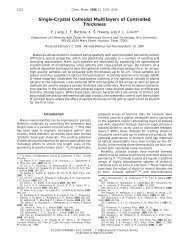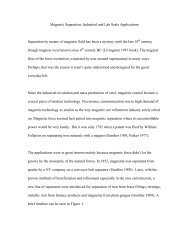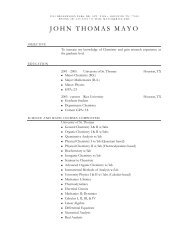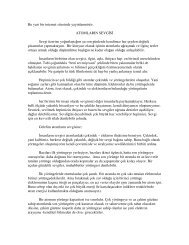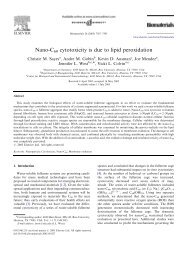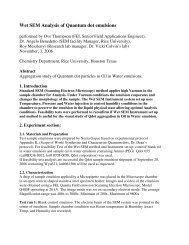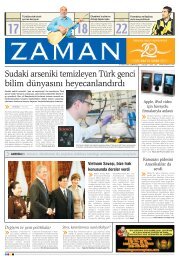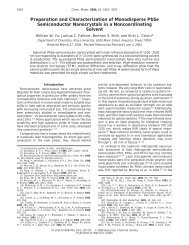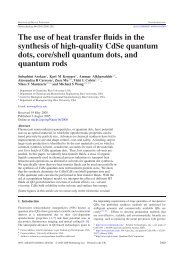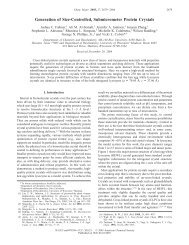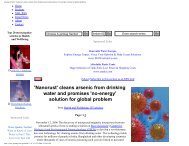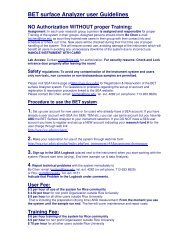Photodegradation of Congo Red catalyzed by nanosized TiO2
Photodegradation of Congo Red catalyzed by nanosized TiO2
Photodegradation of Congo Red catalyzed by nanosized TiO2
Create successful ePaper yourself
Turn your PDF publications into a flip-book with our unique Google optimized e-Paper software.
52 R.K. Wahi et al. / Journal <strong>of</strong> Molecular Catalysis A: Chemical 242 (2005) 48–56<br />
Fig. 3. DTA pr<strong>of</strong>ile <strong>of</strong> A2 <strong>nanosized</strong> <strong>TiO2</strong> photocatalyst. The endothermic peak<br />
near 100 ◦ C corresponds to the evaporation <strong>of</strong> adsorbed water, while the absence<br />
<strong>of</strong> a sharp exothermic peak between 350 and 450 ◦ C indicates the 100% crystallinity<br />
(i.e., no amorphous phase) <strong>of</strong> the <strong>nanosized</strong> <strong>TiO2</strong> powder.<br />
BET surface areas ranged from 28 to 251 m 2 g −1 in the<br />
10 <strong>nanosized</strong> <strong>TiO2</strong> powders studied here. Generally, powder<br />
with smaller particle size had higher surface area. But R1 and<br />
AR2 had only about 50% surface area (110–123 m 2 g −1 )<strong>of</strong>A1<br />
(251 m 2 g −1 ) with similar particle size (∼ 5 nm), largely due to<br />
the extensive aggregation <strong>of</strong> those particles (Fig. 4).<br />
The absence <strong>of</strong> any characteristic TMAH peaks in the FTIR<br />
spectrum <strong>of</strong> anisotropic Rod1 indicated that the TMAH surfactant<br />
was completely removed from the nanocrystal surfaces <strong>by</strong><br />
washing and dialyzing (Fig. 5). The same spectrum as Rod1 was<br />
also observed for Rod2 (not shown).<br />
3.2. Photocatalytic decomposition <strong>of</strong> <strong>Congo</strong> <strong>Red</strong> over<br />
<strong>nanosized</strong> <strong>TiO2</strong> photocatalysts<br />
The photocatalytic activity <strong>of</strong> each <strong>TiO2</strong> catalyst was quantified<br />
using the half-life time (t1/2)fora10mgL −1 (14 mol L −1 )<br />
<strong>Congo</strong> <strong>Red</strong> solution and the Langmuir–Hinshelwood rate constant<br />
(k). The values <strong>of</strong> t1/2 and k were expressed on both a<br />
unit mass basis (t1/2,m, km) and a unit surface area basis (t1/2,s,<br />
ks). Activities evaluated on a unit mass basis reflected largely<br />
Fig. 4. TEM pictures <strong>of</strong> <strong>nanosized</strong> <strong>TiO2</strong> photocatalysts.<br />
Fig. 5. FTIR spectra <strong>of</strong> TMAH and Rod2. The absence <strong>of</strong> characteristic TMAH<br />
resonances in Rod2 confirms that TMAH was completely removed from nanorod<br />
surfaces.<br />
the influence <strong>of</strong> surface area on a catalyst’s performance, while<br />
activities expressed on a unit surface area basis (i.e., specific<br />
activities) reflected the effects <strong>of</strong> physical properties other than<br />
surface area.<br />
The <strong>Congo</strong> <strong>Red</strong> decomposition curves indicate that the A2,<br />
A3 and P25 catalysts had similar activity (t1/2,m = 1.5–3.5 min g)<br />
on a mass basis, while the mixed-phase powders AR1 and AR2<br />
had a little longer half-life time (t1/2,m ∼ = 5 min g) (Fig. 6 and<br />
Table 2). In contrast, the photocatalytic reaction was considerably<br />
slower (t1/2,m = 15–30 min g) over Rod1 and Rod2 anatase<br />
nanorods. And, very slow photodegradations <strong>of</strong> <strong>Congo</strong> <strong>Red</strong><br />
were observed over rutile R1 (t1/2,m = 120 min g). The massbased<br />
activities (t1/2,m) <strong>of</strong> the <strong>TiO2</strong> catalysts increased in the<br />
order R1 < A1 < Rod2 < Rod1 < AR1 ∼ = AR2



